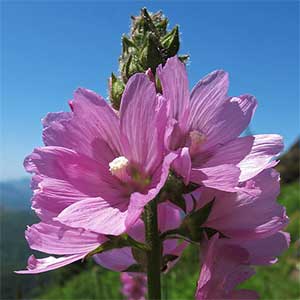Sidalcea neomexicana
Sidalcea hirtipes
mountain sidalcea, New Mexico checkerbloom, New Mexico checkermallow, New Mexico or salt-spring checkerbloom, Rocky Mountain checkerbloom, salt spring checkerbloom
bluff mallow, bristly-stem checker-mallow, bristly-stem checkerbloom, hairy-stem checkermallow
1–several, clustered, erect or ascending from slightly decumbent base, unbranched or branched, solid, infrequently hollow in robust plants, sometimes glaucous, proximally usually coarsely, densely to moderately bristly-hirsute, hairs often pustulose to sparsely stellate-hairy, sometimes glabrous, distally usually minutely puberulent or glabrous.
several, scattered, erect, arising from rhizome apices, usually slightly hollow, densely, harshly bristly-hirsute, hairs stiff, pustular, simple, forked, or stellate, often 2–2.5 mm.
basal and cauline, cauline 3+;
stipules linear to wide-lanceolate, 4–8 × 1–2 mm;
petioles of proximalmost leaves 10–25 cm, reduced distally to shorter than blade, to 5 times blade length;
blade fleshy, margins often short-ciliate, surfaces sparsely hairy, less so adaxially, hairs simple-hirsute to stellate, appressed, basal orbiculate, unlobed, margins crenate, or shallowly 5–7(–9)-lobed, (1.5–) 2–6(–8) × (1.5–)2–6(–8) cm, base cordate, apex rounded, lobes with margins crenate to dentate, apex acute, distal cauline highly reduced or not, deeply, palmately (3–)5–7(–9)-lobed, smaller, ultimate divisions linear, margins entire.
basal and cauline;
stipules linear-subulate, 6–8 × 1–1.5 mm;
petioles of proximal leaves 20–30 cm, 3 times as long as blades, reduced distally to 1/2 times as long as blades;
blades: basal and proximalmost orbiculate to reniform, shallowly 5–9-lobed, 10–15 × 10–15 cm, thick, base narrowly cordate, lobe margins coarsely crenate-dentate, apex rounded, surfaces coarsely hirsute, hairs stiff;
distal orbiculate, deeply palmately 5–7-lobed, incised ± to base, lobes sometimes lobed again, base cuneate, apex acute, deeply 2–3-toothed, surfaces long-hirsute or with 2–4-rayed, stellate hairs abaxially.
erect to ascending, open or dense, calyces not conspicuously overlapping except sometimes in bud, unbranched or branched, 20+-flowered, proximal flowers spaced 1+ cm apart, elongate, sometimes 1-sided, 10–25 cm, elongating in fruit;
bracts linear to lanceolate, undivided or deeply 2-fid, 4–10 mm, usually equaling or longer than pedicels.
erect, spiciform to subcapitate, dense, calyces usually conspicuously overlapping in flower and sometimes in fruit, proximals usually long-pedunculate, unbranched or branched, 20+-flowered, 10+ flowers usually open on spike at same time, not interrupted, not 1-sided, usually to 8 cm, usually not elongate but sometimes slightly elongated in some populations and to 20 cm in fruit;
bracts paired or single, linear, distal undivided, proximal distinct to base, 6 mm, mostly slightly longer than pedicels.
5–8(–40) mm, equaling to much longer than calyx in fruit;
involucellar bractlets absent.
1–3(–5) mm;
involucellar bractlets absent.
bisexual or, less frequently, unisexual and pistillate, plants gynodioecious;
calyx 5–8(–10) mm, often accrescent, sparsely hairy, hairs simple, to 1 mm, pustulose, sometimes small, stellate, infrequently glandular, surface not obscured;
petals pale pinkish rose or pale lavender-purple, bases paler, rarely white, veins usually pale, (6–)10–20(–25) mm, pistillate 8–12 mm, bisexual 18–20 mm;
staminal column 5–6 mm, hispid-puberulent;
anthers white;
stigmas (7 or)8 or 9.
bisexual or unisexual and pistillate, plants gynodioecious;
calyx often purple tinted, 9–11 mm, to 11–16 mm in fruit, margins ciliate, hairs 1–2 mm, surfaces finely stellate-hairy at base and with coarser, longer, simple and stellate hairs apically;
petals usually pale pink to rose-lavender, rarely white, slightly or not pale-veined, (9–)10–21 mm, pistillate often 9–14 mm;
staminal column 5–7(–10) mm, hairy;
anthers white;
stigmas 5–10.
1.5 mm.
2.5–3.5 mm.
5 mm diam.;
mericarps (7 or)8 or 9, 2–3 mm, ± glabrous, sides thin, smooth to slightly reticulate-veined, not pitted, mucro 0.5–0.8(–1) mm.
7–8 mm diam.;
mericarps 5–10, 3.5–4 mm, glabrous or sparsely stellate-puberulent, roughened, prominently reticulate-veined, sides rugose and pitted, back less so, mucro 0.6–0.8 mm.
= 20.
= 60.
Sidalcea neomexicana
Sidalcea hirtipes
Sidalcea neomexicana is variable among and within populations. It is similar to S. covillei and S. sparsifolia, the former possibly derived from it. Sidalcea neomexicana usually can be distinguished by its fleshy roots; hirsute stems; slender pedicels (especially in fruit); pustulate, coarse calyx hairs; and relatively smooth mericarp surfaces. Some plants (in California and Mexico) are well adapted to hot desert springs; overall, S. neomexicana appears to have roots and a rootstock adapted to marshy conditions. It ranges farther south than any other Sidalcea. E. M. F. Roush (1931) recognized no subspecific taxa; C. L. Hitchcock (1957) accepted four geographically and morphologically defined subspecies, three of which (crenulata, neomexicana, thurberi) occur north of Mexico.
(Discussion copyrighted by Flora of North America; reprinted with permission.)
Of conservation concern.
Sidalcea hirtipes is uncommon and known from Clatsop, Lincoln, and Tillamook counties in Oregon and Clark, Lewis, and Wahkiakum counties in Washington. Its elevation and habitat vary, and it seems as much at home on steep coastal cliffs as in more inland, historic prairies and mountain meadows. Populations can appear to be large because of the long-rhizomatous and clonal nature of the plants; they are few and local. It is threatened by grazing, loss of habitat, fire suppression, road construction and maintenance, and changes in hydrology. It is a candidate for listing in Oregon and has been listed as endangered in Washington. Sidalcea hirtipes is characterized by its coarse indument of bristle hairs, its generally compact spikelike inflorescences, its relatively few, large, erect, hirsute leaves, and, especially, its extensive, coarse rhizomes. The inflorescences in some populations are elongated in fruit; its range, hirsute indument, and thick leaves along with coarse rhizomes help to distinguish it from other species. Stem internode length varies depending on habitat, as in many other Sidalcea. Molecular data suggest a relationship among S. hirtipes and S. asprella, S. celata, and S. gigantea (K. Andreasen and B. G. Baldwin 2003).
(Discussion copyrighted by Flora of North America; reprinted with permission.)


